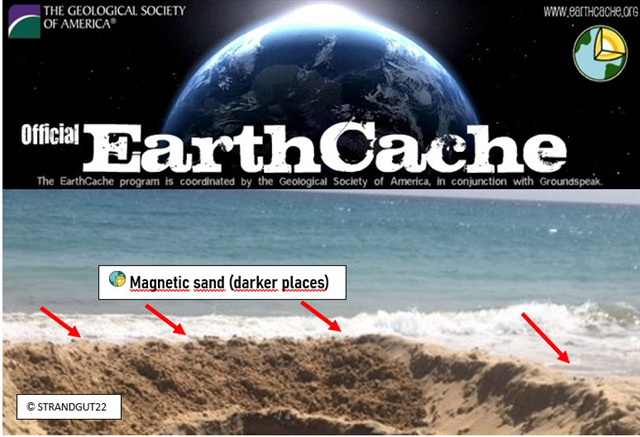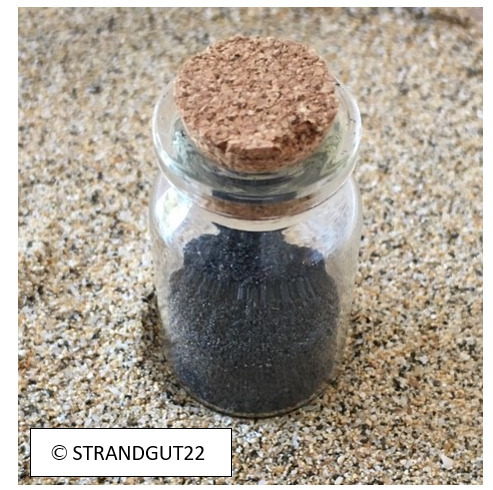Magnetic Sand at Jandia


Arena magnética en la playa de Jandia (Fuerteventura)
¿Qué es la arena magnética?
El color de la arena es gris oscuro o negruzco. El mineral de hierro predominante en la arena es la magnetita Fe3O4, por lo que el contenido de hierro puro puede estar entre 54% y 60% dependiendo de la ubicación y la calidad. (Fuente: Wikipedia)
¿Cómo se crea la arena magnética?
Después del aluminio, el hierro es el metal más común en la corteza terrestre. Debido a la actividad volcánica, puede transportarse desde las áreas más profundas de la corteza o desde el manto superior hasta la superficie de la tierra en cantidades relativamente grandes, donde se convierte en parte de la roca de lava en forma de minerales de hierro. Hace muchos millones de años, se crearon áreas con rocas que contenían hierro en varios puntos de la tierra, luego se erosionaron durante largos períodos de tiempo y el material de roca triturada se llevó de los ríos hacia el mar. Las piedras o granos pequeños pero pesados se depositaron en el área de la boca de los ríos, se distribuyeron en las costas por el viento, las olas y las mareas y se concentraron debido a su mayor peso específico que la arena normal. El resultado fueron fondos marinos, playas y algunas dunas, que hoy en día tienen grandes cantidades de arenas de hierro explotables. (Fuente: Wikipedia)
¿Cómo puedes filtrar la arena magnética?
Para este experimento, debe recoger una pequeña cantidad de arena (aprox. 200 g).
Tienes que recoger la arena donde puedes encontrar las manchas oscuras en la playa.
A continuación, necesita un imán, una pequeña bolsa de plástico y un recipiente (por ejemplo, un vaso pequeño).
Seca la arena y la extiende sobre una estera.
Coloque el imán en la bolsa y guíelo por la arena (de un lado a otro).
Luego sostenga la bolsa sobre el contenedor y saque el imán de la bolsa. El mineral cae en el recipiente sin tener que sacarlo laboriosamente del imán.

Requisitos para poder iniciar sesión en la caché de la Tierra:
Encuentra la sección de playa en las coordenadas dadas y mírala cuidadosamente.
Tarea:
- Busque manchas oscuras en la arena de la playa.
Filtre la arena como se describe arriba y ponga una foto de su resultado en su registro. Determine el porcentaje de partículas magnéticas en su muestra (en%). ¿Las magnetitas tienen colores diferentes?
Preguntas:
- Examinar el tramo de la playa. ¿Las áreas oscuras de la arena magnética están distribuidas uniformemente sobre la playa o hay áreas con una mayor acumulación? ¿Cuál puede ser la razón de esto?
- Voluntariamente ! Si tiene un microscopio, observe más de cerca su muestra. ¿Qué reconoces?
Las pautas de EarthCache no requieren que tenga que esperar a que el "OK" del propietario registre el caché. Envíenos sus respuestas por correo electrónico, luego puede registrar EarthCache de inmediato. Nos pondremos en contacto con usted si necesita aclaraciones sobre sus respuestas / soluciones.
Diviértete con este EarthCache.

Magnetischer Sand am Strand von Jandia (Fuerteventura)
Was ist magnetischer Sand?
Die Farbe des Sandes ist dunkelgrau oder schwärzlich. Das im Sand vorherrschende Eisenmineral ist Magnetit Fe3O4, wobei der reine Eisenanteil je nach Fundort und Qualität zwischen 54 % und 60 % liegen kann. (Quelle: Wikipedia)
Wie entsteht magnetischer Sand?
Eisen ist nach Aluminium das häufigste Metall in der Erdkruste. Durch vulkanische Aktivität kann es aus den tieferen Bereichen der Kruste oder aus dem oberen Mantel in relativ großen Mengen an die Erdoberfläche transportiert werden, wo es in Form von Eisenmineralen Bestandteil des Lavagesteins wird. An verschiedenen Stellen der Erde sind so vor vielen Millionen Jahren Gebiete mit eisenhaltigem Gestein entstanden, anschließend über lange Zeiträume erodiert und zerkleinertes Gesteinsmaterial davon von den Flüssen in Richtung Meer getragen worden. Die kleinen aber schweren Steine oder Körner lagerten sich im Mündungsbereich der Flüsse ab, wurden durch Wind, Wellen und Gezeiten an den Küsten verteilt und auf Grund ihres größeren spezifischen Gewichtes, als des normalen Sandes, konzentriert abgelagert. So entstanden Meeresböden, Strände und teilweise Dünen, die heute über große Mengen an ausbeutungsfähigen Eisensanden verfügen. (Quelle: Wikipedia)
Wie könnt ihr den magnetischen Sand filtern?
Für diesen Versuch müßt ihr eine kleine Menge Sand (ca. 200g) einsammeln.
Ihr müßt den Sand dort einsammeln, wo ihr die dunklen Stellen am Strand findet.
Als nächstes benötigt ihr einen Magneten, eine kleine Plastiktüte und ein Behältnis (z.B. ein kleines Glas).
Trocknet den Sand und breitet ihn auf einer Unterlage aus.
Den Magneten packt ihr in die Tüte und führt diesen durch den Sand (hin-und her).
Haltet anschließend die Tüte über das Behältnis und nehmt den Magneten aus der Tüte. Das Mineral fällt somit in das Behältnis, ohne das ihr es umständlich vom Magneten entfernen müßt.

Voraussetzungen, um den Earth Cache loggen zu können:
Sucht den Strandabschnitt an den angegebenen Koordinaten auf und betrachtet diesen aufmerksam.
Aufgabe:
- Sucht am Strand nach dunklen Stellen im Sand.
Filtriere den Sand, wie oben beschrieben und stelle ein Foto deines Ergebnisses in deinen Log. Ermittle den Anteil an magnetischen Partikeln in deiner Probe (in %). Haben die Magnetite unterschiedliche Farben?
Fragen:
- Betrachte den Strandabschnitt genauer. Sind die dunklen Stellen des magnetischen Sandes gleichmäßig über den Strand verteilt oder gibt es Flächen mit einer erhöhten Ansammlung? Was mag der Grund dafür sein?
- Freiwillig ! Wenn du ein Mikroskop hast, schaue deine Probe genauer an. Was erkennst du?
In den EarthCache-Guidelines ist bewusst nicht vorgesehen, dass auf eine Logfreigabe seitens des Owners gewartet werden muss. Schickt uns bitte eure Antworten per Mai, anschließend dürft Ihr den EarthCache sofort loggen. Wir melden uns bei Euch, sollte es zu Euren Antworten/Lösungen Klärungsbedarf geben.
Viel Spaß mit diesem EarthCache.

Magnetic sand on the beach of Jandia (Fuerteventura)
What is magnetic sand?
The color of the sand is dark gray or blackish. The predominant iron mineral in the sand is magnetite Fe3O4, whereby the pure iron content can be between 54% and 60% depending on the location and quality. (Source: Wikipedia)
How is magnetic sand created?
After aluminum, iron is the most common metal in the earth's crust. Due to volcanic activity, it can be transported from the deeper areas of the crust or from the upper mantle to the surface of the earth in relatively large quantities, where it becomes part of the lava rock in the form of iron minerals. Many millions of years ago, areas with iron-bearing rock were created at various points on the earth, then eroded over long periods of time and crushed rock material was carried away from the rivers towards the sea. The small but heavy stones or grains were deposited in the mouth area of the rivers, were distributed on the coasts by wind, waves and tides and were concentrated due to their greater specific weight than the normal sand. The result was sea floors, beaches and some dunes, which today have large amounts of exploitable iron sands. (Source: Wikipedia)
How can you filter the magnetic sand?
For this experiment you have to collect a small amount of sand (approx. 200g).
You have to collect the sand where you can find the dark spots on the beach.
Next you need a magnet, a small plastic bag and a container (e.g. a small glass).
Dries the sand and spreads it on a mat.
Put the magnet in the bag and guide it through the sand (back and forth).
Then hold the bag over the container and take the magnet out of the bag. The mineral falls into the container without having to laboriously remove it from the magnet.

Requirements to be able to log the Earth Cache:
Find the beach section at the given coordinates and look at it carefully.
Task:
- Look for dark spots on the sand on the beach.
Filter the sand as described above and put a photo of your result in your log. Determine the percentage of magnetic particles in your sample (in %). Do the magnetites have different colors?
Questions:
- Examine the stretch of the beach. Are the dark areas of the magnetic sand evenly distributed over the beach or are there areas with an increased accumulation? What may be the reason for this?
- Voluntarily ! If you have a microscope, take a closer look at your sample. What do you recognize?
The EarthCache guidelines do not require that you have to wait for the "OK" of the owner to log the cache. Please send us your answers by eMail, then you can log the EarthCache immediately. We will get back to you if there is a need for clarification regarding your answers / solutions.
Have fun with this EarthCache.